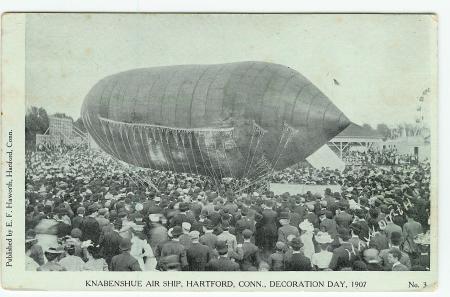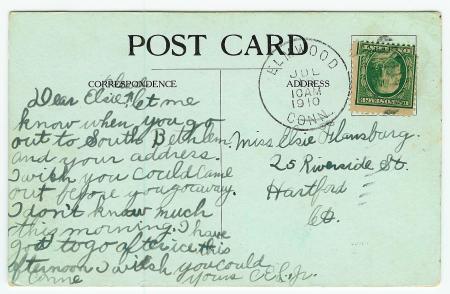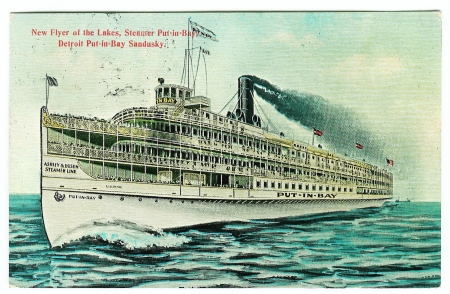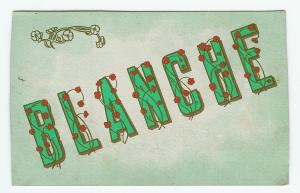Let us take a glimpse into the Hartford, Connecticut of the early twentieth century, focusing on some unusual forms of locomotion. We shall use as our looking glass the lens of vintage postcards, four to be exact, and let them weave a story.
FIRST postcard – Combination Car
Obverse caption: Combination Car, Engine House No. 2, H. F. D. , Hartford, Conn.
A combination car was used by the fire department as a conveyance for both chemicals and hoses. Note the polished brass chemical fire extinguisher mounted next to the driver of the fire engine, and the coiled fire hose directly behind him. An extension ladder also can be seen attached to the far side of the vehicle. Since this card is postmarked in 1910, the combination car pictured is a very early model that used gasoline as its motive power instead of horses. The drive train consisting of chains and gears is visible in front of the rear wheels. The gas tank is barely visible under the front of the vehicle, and the gasoline engine was most likely mounted under the center of the car, since the crank between the O and M of COMBINATION was probably used as the engine starter. A beacon or searchlight is mounted on the front of the fire engine, and two kerosene lanterns are affixed to the upper corners of the rear body. Five uniformed firemen of the Hartford Fire Department, Engine House Number 2, are seated in the machine, ready to spring into action should the fire bell ring. A young man in the background admires the shiny new piece of firefighting equipment.
SECOND postcard – Life Net
Obverse caption: Life Net, Engine House No. 14, H. F. D., Hartford, Conn.
In this vintage post card, another item in the firefighter’s arsenal is displayed: The life net! While the life net is not in itself a means of locomotion, it certainly can be considered the life-saving brake when a person, trapped by flames and suffocating smoke, must jump from an upper-story window and use the force of gravity as the sole means of locomotion. Eleven firemen of the Hartford Fire Department, Engine House Number 14, hold the circumference of the sturdy rope-mesh life net with a firm grip, while a twelfth firefighter stands ready to direct the others to the exact location required to ensure a safe deceleration and gentle return to terra firma.
Dave Dube of Old Paper Art inquires about the “HOSE” lettering above the middle bay doors:
The font is somewhat unusual, being slightly wider than high, which gives the letter O the appearance of an egg laying on a table. Perhaps the stone engraver felt constrained by the dimensions of the keystone. I do not know why that particular bay is labeled, whereas the bays on either side of it appear to be nameless. One of the more interesting aspects of this postcard view is the reflections that can be seen in the large glass windows of the bay double-doors, and even in some of the smaller glass panels. Apparently, the fire house building was constructed across the street from a park or vacant land, or at least a tree-lined roadway, since trees easily can be seen in the reflections. The trees are leafless, indicating that the original photo upon which this lithochrome postcard is based must have been taken in early spring or late autumn.
THIRD postcard – Police Station
Obverse caption: Police Station, Hartford, Conn.
The impressive stone edifice of the Hartford, CT. Police Department dominates the obverse of this card postmarked on June 23,1910. A carriage whose motive power is a one horsepower engine – meaning, that is, a single horse – is parked outside of a main entrance to the building. The vehicle bears signage on the black-paneled side, but the words are not legible at the resolution of the litho-chrome printing method employed by the printer. So, one can speculate that this might be some sort of official conveyance, perhaps the police cruiser or paddy wagon of its day. It could also be a horse-drawn taxi cab, or the carriage used by one of the local Hartford businesses to deliver supplies to the police department. The sender of the postcard has written in the upper-right corner of the postcard front: “That is where they’re going to put me next”
FOURTH postcard – Knabenshue Air Ship
Obverse caption: KNABENSHUE AIR SHIP, HARTFORD, CONN. DECORATION DAY, 1907
The airship – or dirigible – pictured on the obverse of this postcard was not an everyday fixture of the City of Hartford, Connecticut, but rather was a special feature brought in by its owner, Augustus Roy Knabenshue – aka Roy Knabenshue – just for the Decoration Day festival held in 1907. The dirigible was powered by a small gasoline engine that drove a propeller, and A. Roy Knabenshue was able to pilot the lighter-than-air craft with amazing dexterity. It’s a good thing that the airship would make a nearly vertical ascent, because it would be well-nigh impossible to navigate along the ground through the sea of hundreds, if not thousands, of eager onlookers. Perhaps the Hartford fire department was on hand, ready with their combination car to aid Roy Knabenshue if his hydrogen-filled gas bag caught on fire. The emergency crew should bring the life net to the scene, too, in case Mr. Knabenshue fell from the dizzying heights that his wonderful air-ship could take him.
Now here are the images of the backs of the postcards. These are not presented in the same order as the fronts (above), since the first three postcards are all from the same sender (C. E. L., Jr.) to the same recipient (Miss Elsie Flansburg), and are presented in chronological order according to the postmark date.
*+*+* BEGIN LIFE NET REVERSE *+*+*
Life Net reverse (Postmarked May XX, 1910 10:00 AM from Elmwood, Connecticut):
Dear Elsie: I received your picture and thank you very much. Charles E. and I are going to have some little pictures taken. I will send you one of those and one of Dick and me when I get some finished. Yours C. E. L., Jr.
Then at the top of the back of the postcard, C. E. L. has written: P. S. We play a game at Pope Park 1st diamond Sat. afternoon.
*+*+* END LIFE NET REVERSE *+*+*
*+*+* BEGIN COMBINATION CAR REVERSE *+*+*
Combination Car reverse (Postmarked June 2, 1910 6:00 PM from Elmwood, Connecticut):
Dear Elsie: We won the game Sat. 11-12. We came near getting beat but Chas. Elwood brought in the winning run. If you come over to any of our games bring another girl because there is none that go from here. The message is unsigned, but is evidently from C. E. L., Jr.
Then at the top of the back of the postcard: Come out before you go away. WLOL
*+*+* END COMBINATION CAR REVERSE *+*+*
*+*+* BEGIN KNABENSHUE AIRSHIP REVERSE *+*+*
Roy Knabenshue airship reverse (Postmarked July 16, 1910 10:00 AM from Elmwood, Connecticut):
Dear Elsie, please let me know when you go out to South Bethlem. And your address. I wish you could come out before you go away. I don’t know much this morning. I have got to go after ice this afternoon. I wish you could come. Yours, CEL., Jr.
*+*+* END KNABENSHUE AIRSHIP REVERSE *+*+*
*+*+* BEGIN HARTFORD POLICE STATION REVERSE *+*+*
Police Station, Hartford, Connecticut reverse (Postmarked June 23, 1910 9:00 PM from Hartford, Connecticut):
Hello old chap didn’t mean to make you wait so long. Have been busy with the girls and got careless about writing. Hope you are getting along good with the girls and don’t kiss them too much. Please excuse writing awful bad pen ain’t got a cent to buy another. Ans soon Ed. B.
*+*+* END HARTFORD POLICE STATION REVERSE *+*+*
These vintage postcards are presented as the entry in the Festival of Postcards 9th Edition: Locomotion.


















